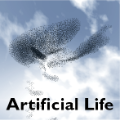The Self-Optimization (SO) model is a useful computational model for investigating self-organization in "soft" Artificial life (ALife) as it has been shown to be general enough to model various complex adaptive systems. So far, existing work has been done on relatively small network sizes, precluding the investigation of novel phenomena that might emerge from the complexity arising from large numbers of nodes interacting in interconnected networks. This work introduces a novel implementation of the SO model that scales as $\mathcal{O}\left(N^{2}\right)$ with respect to the number of nodes $N$, and demonstrates the applicability of the SO model to networks with system sizes several orders of magnitude higher than previously was investigated. Removing the prohibitive computational cost of the naive $\mathcal{O}\left(N^{3}\right)$ algorithm, our on-the-fly computation paves the way for investigating substantially larger system sizes, allowing for more variety and complexity in future studies.
翻译:自操作化模型(SO)是调查“软”人工生命(ALife)自我组织的有用计算模型,因为事实证明该模型非常笼统,足以模拟各种复杂的适应系统。到目前为止,已经对相对较小的网络规模进行了现有工作,从而无法调查由于在互联网络中互动的大量节点产生的复杂现象。这项工作引进了对SO模型的新应用,该模型在节点数量方面以$mathcal{O ⁇ left(N ⁇ 2 ⁇ right)为单位,并展示了SO模型对系统规模比以前调查的要大若干级的网络的适用性。消除了天真的 $mathcal{O ⁇ left(N ⁇ 3 ⁇ right) 算法的令人难以接受的计算成本,我们的飞行计算为调查大得多的系统规模铺平铺平了道路,使得今后的研究能够更加多样化和复杂。




